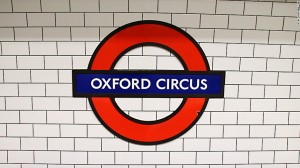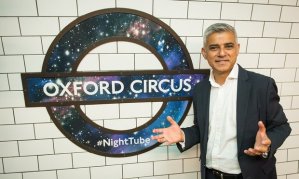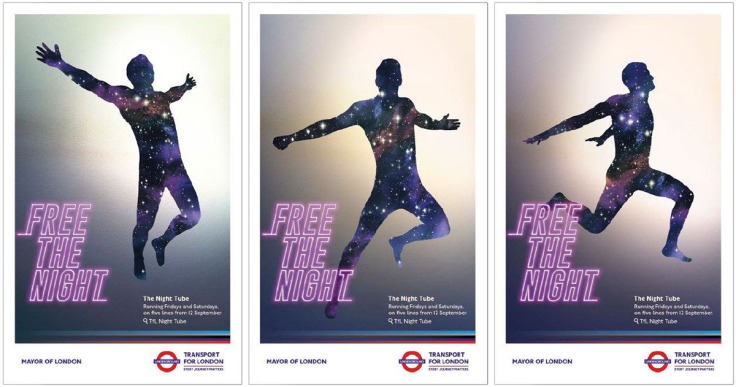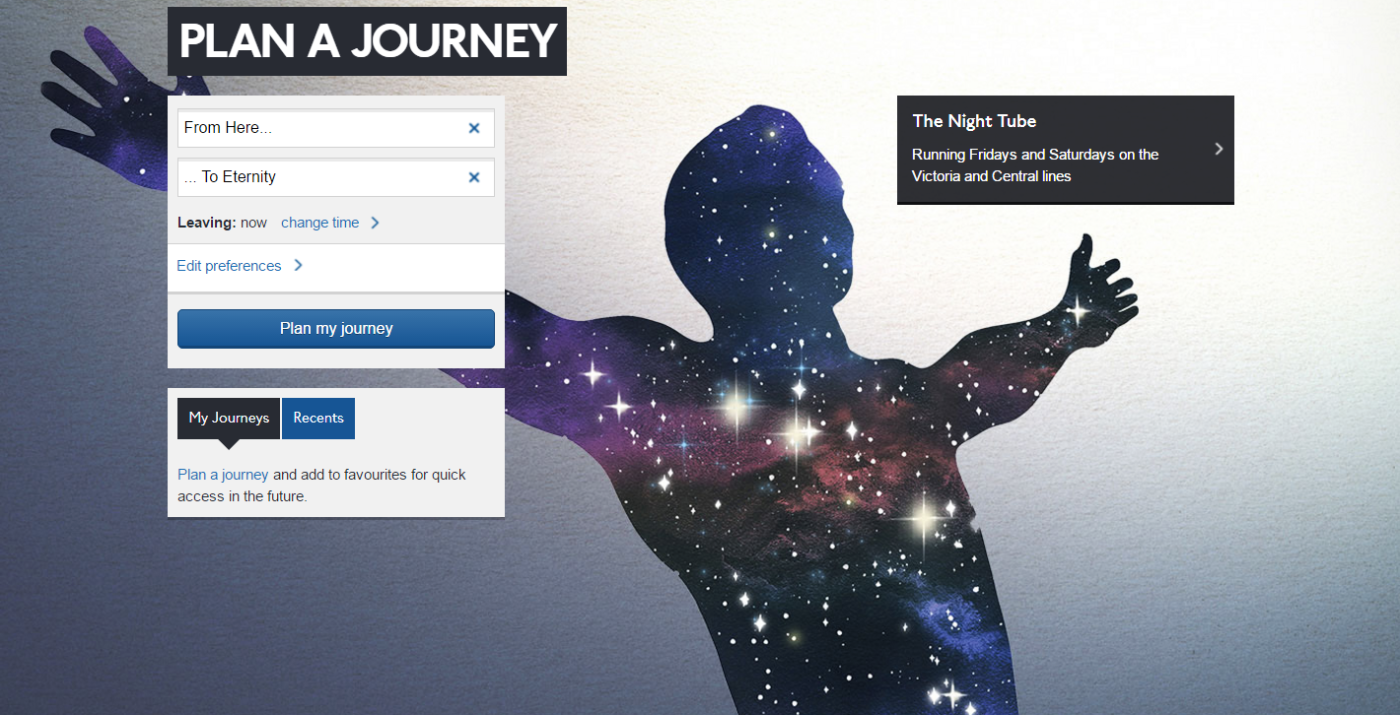24-hour London has arrived.
As from tonight, London Underground Limited’s Victoria and Central line will offer trains around the clock, on Fridays and Saturdays at least. Trailing the light blue and read, Jubilee, Piccadilly and Northern lines are scheduled to follow suit in the wonderfully broad season of autumn.
London, London, the city that… Never gets too carried away.
And of course, after an unprecedented spell of summer sun, the heat rippling the tarmac of London’s streets as the nation basks in the medal haul of a Rio winter, the City herself welcomed this long-awaited day with grey skies and a hanging mist of rain. London, London, the city that… Never gets too carried away.
As master overseer TfL frames it, the switch from an archaic timetable that had heavy gates close on many a good night with cries of “last tube” is a result of huge and ongoing upgrades to the system and a loose analysis of weekend night that’s found transport demand soar by 70% since 2000. In truth, few think a 24-hour tube isn’t well overdue. London, one of the world’s few legitimate international cities, can hardly have avoided being a 24-hour city on the way to that accolade, even as it was happy to leave the pop-culture aspects to its great North American rival.
But the great subway network of New York, operating 24-hours since its opening in 1904, was designed to do so with its multiple tunnels and tracks catering for express and stopping services. London’s, the oldest in the world was not so prescient when it arrived in the 1860s. The cost of early progress in transportation, is slow updating.
Alternatives
 And during London Underground’s 150 year life, London’s achieved its round the clock nature in spite of its deepest and most hidden transport. In the city’s darkest hours, it provided protection and security, while the events of the Second World War warped and changed the Underground’s expansion and future. Revellers and workers have had to improvise over the years, with no end of alternatives to a round the clock transit. Just see the recent, fantastically framed shots of Jeremy Corbyn propped at the front of a Night Bus. I saw a guy rip a door off a night bus once, but then, that’s another story. Those snaps and tales won’t be so common soon.
And during London Underground’s 150 year life, London’s achieved its round the clock nature in spite of its deepest and most hidden transport. In the city’s darkest hours, it provided protection and security, while the events of the Second World War warped and changed the Underground’s expansion and future. Revellers and workers have had to improvise over the years, with no end of alternatives to a round the clock transit. Just see the recent, fantastically framed shots of Jeremy Corbyn propped at the front of a Night Bus. I saw a guy rip a door off a night bus once, but then, that’s another story. Those snaps and tales won’t be so common soon.
Alternatively, there were always the black cabs, the minicabs, the south of the river trap and more recently the Uber revolution. And as to prove the separate timeline that the London Underground resolutely exists in, in the same month Uber puts driverless cars on the streets of Pittsburgh, London’s tube network goes 24-hour.
24 hours to go
So it’s late, erroneous, not quite true to sound bite that today’s the day that London becomes a 24-hour city. For many travellers, some who’ll forget, it’s just a nudge of flexibility and about time. But its impact will be huge. The socio-economical impact could exceed current expectations. In 2015, TfL estimated that a 24-hour service will boost the local economy by £360m, supporting 2,000 jobs, not factoring in supported industries. Now, that’s been stretched to project a £6.4bn addition to the city economy by 2030. A decade after licensing restrictions dating back to the First World War were eased, bars and nightlife will grow with confidence as consumers have their travel plans eased and workers a safe route home to further away. Swathes of housing at the end of lines will compound their value increases, the property bubble will undulate once again at the extremities of Greater London.
So accountability is one reason for marketing the something that defies marketing to some degree. Since the single lines fell under a single controlling interest in 1930, LUL and now TfL is subject to huge scrutiny, even in its local government guise. there are not only passenger commitments but everything must be evaluated for the people of London.
A bit previous
A scent of the bullish forging forward regardless that defined much of the Johnson Mayoral years
But there are factors that have increased the need for a coherent marketing campaign. One issue is that the service is arriving almost a year late. Originally planned to be in place before last year’s Rugby World Cup, the posters arrived last summer announcing a September launch date that came and went like the last train they hoped to eliminate.
Described, with the wonderful understatement the phrase requires, as “a bit previous”, that was a mistake that had failed to take Union negotiations into account. Still, between the June 2015 announcement and January 2016, LUL had managed to spend £608,214 on marketing the Night Tube, £461,045 of that on placement of advertising. So the delay and back-tracking, which can’t help but have a scent of the bullish forging forward regardless that defined much of the Johnson Mayoral years, had to incorporate a little more spin than might have been planned. And just as the city’s bike scheme that Ken Livingstone had devised fell into Johnson’s legacy, so the Night Tube will fall to fresh Mayor Sadiq Khan.
The recent days have been fuelled by claims that the service will be more than a stretcher service for revellers; that it will remain safe, unlike the reputation that has long dogged the New York’s subway; that the launch is a sad time for the quiet and introverted Londoners.
Because for all the stimulus to London’s nightlife, it’s hard to shake the impression in many people’s mind that a night tube is synonymous with food, damage, drunkenness and fluids, bodily and otherwise. Staggered from licensing lightening, the staggered approach hasn’t helped Londoners’ predisposition to drinking to schedule. Were the Capital to erupt in a wave of balmy, dry night-time conditions and resolve around continental cafes pushing the finest Courvoisier-fed coffees, it would take two generations or so for the British to stop downing pints before 11. While the horror of 2004’s Creep can now be archived as period, British drinking habits likely never will.
Opportunity
The Tube is a hotbed of marketing
 So, to side-step this, as with most things the marketing had to reflect the opportunity, the PR sound bites the economy. The imagery has been the starscape, captured in the distinctive outline of the LUL logo or an active human body. What can that mean?
So, to side-step this, as with most things the marketing had to reflect the opportunity, the PR sound bites the economy. The imagery has been the starscape, captured in the distinctive outline of the LUL logo or an active human body. What can that mean?
Well, it’s night after all. But it’s also opportunity. Far more aspirational than the neat, but too slick blue toned night tube maps that emerged last year. Complete with owl, those made sure people understood what was meant by the Tube opening for approximately four hours longer than it currently did. But it’s crucial that the general campaign allays fears and drives up support, as important as maintaining passenger numbers themselves. It’s crucial that TfL avoid the Night Tube earning a reputation for danger or disgust during its early days.
The Tube is a hotbed of marketing, in more ways than one.
It’s a huge blood system of stuck, gawping or floor-gazing commuter blood cells, held on platform pens opposite hoarding boards or standing to the right of endless escalators, sailing steadily past electronic posters. The idea of advertising is synonymous with the Underground. But its boosted by its old, established and sublime brand. The iconic circle known as the Roundel, emerged on platforms in 1908 before breaking into general operational material within four years. The bar came from acquisition and merger, the typeface and design guidelines thanks to Edward Johnston on the eve of the First World War. It didn’t emerge fully formed, neither has it, even up to the modern day, necessarily remained the logo of choice. Many times sub-brands a considered a step away, before they hesitated and fell back. It always ends up there, buoyed by its familiarity and constant imitation.
It’s a huge blood system of stuck, gawping or floor-gazing commuter blood cells
 Perhaps no surprise that LUL has become a master at referencing and building on their design and brand heritage in the digital age. More than ever, adverts appear extolling various safety measures, warnings, benefits and dangers with twists on the brand colours and iconography. The service’s retooling of a 1928 advert is a recent example of them reaching back to make a mark in the age of the meme.
Perhaps no surprise that LUL has become a master at referencing and building on their design and brand heritage in the digital age. More than ever, adverts appear extolling various safety measures, warnings, benefits and dangers with twists on the brand colours and iconography. The service’s retooling of a 1928 advert is a recent example of them reaching back to make a mark in the age of the meme.
In that context, the Night Tube adverts appear slightly underwhelming. A strong departure maybe, but using such broad analogy they can’t avoid blandness. It’s not helped by the service’s stuttered start of course, or the elephant sat at the end of the platform that the city’s let itself down by not pulling its deep spine into the 24-hour world far sooner.
But beneath the surface, it’s reassuring that there’s more to it. The Free the Night campaign may seem a little active and over the top for a service that will always be more associated with taking people home than facilitating them staying out. But the human designs, summoning up cutural memories of galactic superheroes, and the galaxy coated carriages on the Piccadilly line carriages are actually filled with the hand-painted starscapes of artist Essy May. The art that LUL have kept close to its existence the from its platforms to campaigns of poetry and visuals is there, almost to obvious to see. There’s a hidden depth in a deliberately broad campaign.
And it the same may well become true of how London’s final push to being a 24-hour city pans out.


First night over, and the rain’s increased. Still, despite some glorious horror-soaked memes this morning, it was barely a tribute to Boris’ ‘greatest’ hour: banning alcohol on London’s public transport. But then, for all the ‘My God, it’s full of stars’ branding, half the passengers were politicians or journalists (last night – I couldn’t comment on the alcohol ban parties). The most obvious thing after this night of low-key coping is that calling it a Night Tube was probably a mistake. Tube would have been sufficient. And if the idea of 24-hour service is to be met, an idea the pointed difference of ‘Night Tube’ is slightly in opposition to, it’ll no doubt be referred to as just that before too long…
LikeLike